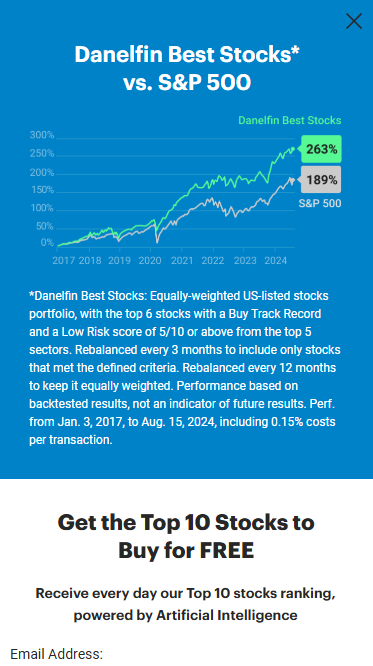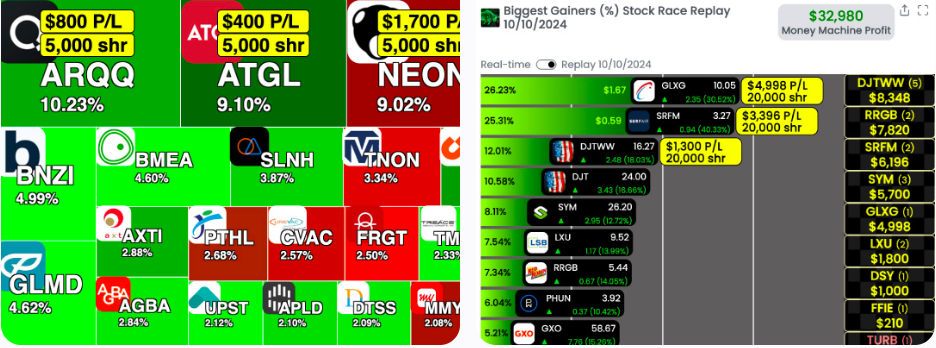20 Excellent Suggestions To Picking AI Stock Picker Platform Sites
20 Excellent Suggestions To Picking AI Stock Picker Platform Sites
Blog Article
Top 10 Tips To Evaluate The Ai And Machine Learning Models Of Ai Analysis And Prediction Of Trading Platforms For Stocks
To guarantee accurate, reliable, actionable insights, it is essential to assess the AI and machine-learning (ML) models utilized by prediction and trading platforms. Models that are not properly designed or overhyped can result in financial losses and incorrect forecasts. Here are the 10 best strategies for evaluating AI/ML models that are available on these platforms.
1. The model's approach and purpose
Clarity of purpose: Determine if this model is intended for short-term trading or long-term investment and risk analysis, sentiment analysis etc.
Algorithm Transparency: Make sure that the platform reveals what kinds of algorithms are employed (e.g. regression, decision trees neural networks or reinforcement-learning).
Customizability. Find out whether the model is able to be tailored to your trading strategy or your risk tolerance.
2. Evaluation of Performance Metrics for Models
Accuracy - Check the model's accuracy in predicting. Don't base your decisions solely on this measure. It may be inaccurate on the financial markets.
Recall and precision - Assess the model's capability to recognize real positives and reduce false positives.
Risk-adjusted returns: Find out if the model's forecasts lead to profitable trades, after adjusting for risk (e.g. Sharpe ratio, Sortino coefficient).
3. Make sure you test the model using Backtesting
Performance from the past: Retest the model by using data from historical times to determine how it been performing in previous market conditions.
Testing on data other than the sample is crucial to prevent overfitting.
Analyzing scenarios: Examine the model's performance in different market conditions.
4. Make sure you check for overfitting
Overfitting signs: Look for models that have been overfitted. They are the models that perform extremely well on training data and poorly on unobserved data.
Regularization methods: Ensure that the platform does not overfit using regularization techniques such as L1/L2 and dropout.
Cross-validation - Ensure that the model is cross-validated in order to assess the generalizability of the model.
5. Review Feature Engineering
Relevant Features: Look to determine whether the model is based on significant characteristics. (e.g. volume, price, technical indicators as well as sentiment data).
The selection of features should make sure that the platform selects features that have statistical value and avoid unnecessary or redundant information.
Updates to dynamic features: Verify that your model has been up-to-date to reflect the latest characteristics and current market conditions.
6. Evaluate Model Explainability
Interpretability - Ensure that the model offers an explanation (e.g. value of SHAP and the importance of features) for its predictions.
Black-box models are not explainable Beware of systems that use complex models including deep neural networks.
The platform should provide user-friendly information: Make sure the platform offers actionable insights which are presented in a manner that traders will understand.
7. Examine the adaptability of your model
Market shifts: Determine if the model can adapt to changing market conditions (e.g. new rules, economic shifts, or black swan-related events).
Verify that your system is updating its model regularly with the latest information. This will increase the performance.
Feedback loops: Make sure the platform is incorporating feedback from users or real-world results to help refine the model.
8. Look for Bias & Fairness
Data bias: Check that the data within the program of training is representative and not biased (e.g. an bias towards specific sectors or periods of time).
Model bias: Find out whether the platform monitors and mitigates biases in the predictions made by the model.
Fairness - Check that the model is not biased towards or against particular sectors or stocks.
9. Evaluation of the computational efficiency of computation
Speed: Determine whether your model is able to produce predictions in real-time or with minimum delay particularly when it comes to high-frequency trading.
Scalability: Find out if the platform is able to handle large amounts of data with multiple users, and without performance degradation.
Resource usage: Examine to make sure your model is optimized for efficient computational resources (e.g. GPU/TPU use).
Review Transparency Accountability
Model documentation: Make sure the platform provides an extensive document detailing the model's architecture and the training process.
Third-party audits : Confirm that your model has been validated and audited independently by a third party.
Error handling: Check to see if the platform has mechanisms for detecting and rectifying model errors.
Bonus Tips
Case studies and user reviews User feedback and case studies to assess the actual performance of the model.
Trial period for free: Test the accuracy and predictability of the model by using a demo or a free trial.
Customer support: Check that the platform can provide solid customer support that can help resolve any technical or product-related issues.
By following these tips you can examine the AI/ML models used by stock predictions platforms and ensure that they are accurate, transparent, and aligned with your goals in trading. View the recommended ai for investing for more advice including ai investment app, ai stock picker, best ai trading app, ai stock market, best ai trading software, ai trade, ai for investing, options ai, incite, ai for investing and more.
Top 10 Tips For Evaluating The Risk Management Of Ai Stock Prediction And Analysis Of Trading Platforms
Risk management plays a vital part in any AI-powered platform for trading stocks. It helps protect your capital by minimizing possible losses and helps you to maximize profits. A platform with robust risk management tools will help you navigate volatile markets and make informed decisions. Here are the 10 best ways to evaluate the risk management capabilities of these platforms. capabilities:
1. Evaluating Stop-Loss or Take-Profit Features
Customizable settings: Make sure you can set the take-profit or stop-loss level for a specific trade.
Find out if the platform allows for trailing stops. They will automatically adapt themselves when market moves in your favor.
Guarantees on stop-loss: see if the platform provides stop-loss assurances, which ensure that your position will close at a certain price, even in volatile markets.
2. Measure Positions Tools
Fixed amount: Make sure that the platform you're using allows you to adjust the size of your position according to a predetermined amount.
Percentage of your portfolio: See if you can set size limits in percentages of your overall portfolio to manage risk proportionally.
Risk-reward-ratio: Determine if the platform lets users set individual risk/reward ratios.
3. Make sure you are receiving assistance with diversification.
Multi-asset trading: Make sure the platform permits you to trade across a variety of asset classes, like ETFs, stocks as well as options. This will allow you to diversify your portfolio.
Sector allocation: Check if the platform offers tools to monitor and manage exposure to sectors.
Geographic diversification: Make sure that the platform you trade on supports international markets in order to spread risk geographically.
4. Assess Margin and Leverage Controls
Margin requirements - Check that the platform clearly explains the margin requirements clearly.
Leverage limits: Check if the platform allows you to set limits on leverage to control the risk exposure.
Margin calls - Examine to see if your service alerts you to margin calls promptly. This will prevent liquidation.
5. Assessment of Risk Analytics and Reporting
Risk metrics: Ensure that the platform has key risk metrics (e.g., Value at Risk (VaR) Sharpe ratio, drawdown) to your portfolio.
Scenario analysis: Ensure that the platform allows you to create different scenarios for the market in order to evaluate the risk.
Performance reports: Verify whether the platform has comprehensive performance reports, which include the risk-adjusted return.
6. Check for Real-Time Risk Monitoring
Monitoring your portfolio: Make sure the platform allows live monitoring of the risk exposure to your portfolio.
Alerts and notifications: Verify whether the platform is able to provide real-time alerts on events that are risky (e.g. margin breach and stop-loss triggers).
Review the dashboards for risk. If you want to see a complete picture of your risks, be sure they're customizable.
7. Assess the effects of stress testing and backtesting
Stress testing. Make sure that the platform allows you to test your strategy or portfolio under extreme market circumstances.
Backtesting - Find out if your platform allows you to backtest strategies with historical information. This is a fantastic way to measure risk and assess the effectiveness of your strategy.
Monte Carlo simulators: Verify that the platform is using Monte Carlo to simulate a number of possible outcomes in order for you to assess the risk.
8. Evaluation of Compliance with Risk Management Regulations
Compliance with the regulatory requirements: Ensure the platform meets the relevant regulations for risk management in Europe as well as the U.S. (e.g. MiFID II).
Best execution: Check if the platform is in line with best execution practices. This will ensure that trades are executed at the most competitive price in order to reduce the chance of slippage.
Transparency: Verify that the platform provides clear and transparent disclosures about the risks.
9. Look for parameters controlled by the user.
Custom risk rules: Make sure the platform you select lets you create your own custom risk management rules.
Automated controls for risk Check to see whether your platform is able to implement risk management policies automatically on parameters you have defined.
Make sure the platform supports manual overrides to automated risk control.
User feedback from reviewers and case studies
User reviews: Study feedback from customers to evaluate the effectiveness of the platform in assessing risk.
Case studies or testimonials should highlight the platform’s capability to handle risks.
Forums for communities Find out if there's an active community of traders who share tips and strategies for risk management.
Bonus Tips
Free Trial: Test the features of the platform for risk management in real scenarios.
Support for customers: Ensure that the platform offers robust support in relation to risk management issues or questions.
Educational resources: Find out whether you can find any educational materials on the best practices for risk management.
Use these guidelines to evaluate the risk management capabilities of AI trading platforms which predict and analyze the price of stocks. Select a platform that has a high degree of risk management, and you'll be able to minimize your losses. It is vital to use a robust risk management tool for navigating volatile markets. Read the best ai software stocks for site recommendations including ai copyright signals, ai stock investing, stock predictor, investing with ai, ai stock predictions, ai software stocks, ai copyright signals, ai software stocks, ai copyright signals, ai stock predictions and more.